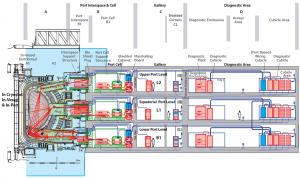Final Procurement Arrangement signed
ITER Diagnostics reached an important milestone in December 2021 when it concluded the last Procurement Arrangement of the diagnostics program.
After signing a Procurement Arrangement with the Japanese Domestic Agency on 13 December 2021 for the design and manufacture of a lower port, the team could breathe a sigh of relief. With the last contract settled, all that remained was to carry out the work.
"We manage the supply of components manufactured all over the world through these Procurement Arrangements (PAs)—and, for some diagnostics, through what we call complementary diagnostics PAs (CDPs)," explains Antonio Torralba Pinedo, in-kind management officer in the Project Control Office. "They bind the Domestic Agency to providing its in-kind contribution, as defined at the start of the project in the ITER Agreement. The Domestic Agency then involves industry by signing one or more contracts for procurement of the system."
Each in-kind contribution constitutes a certain scope and value associated with a given system or component. This value is expressed in terms of an internal project currency, called the ITER Unit of Account (IUA).
Procurement Arrangements are particularly challenging for diagnostics
While diagnostic systems represent less than 5% of the total cost of the ITER project, they account for more than 30% of the Procurement Arrangements.
"Diagnostics are tremendously complicated because of the sheer number of systems," explains Torralba. "Over 100 diagnostics will be installed in the ITER machine, most of them in multiple locations." There may be a single diagnostic in three parts of the tokamak—or in some cases, diagnostics with cables extending to thousands of locations inside the vacuum vessel.
Even when the technologies are well understood, every one of the ITER systems is first-of-a-kind. While many of the diagnostics have already been used in smaller tokamaks, ITER requires systems that are either fully automated or remote controlled—and that can survive in a nuclear environment with huge heat and radiation loads. All systems have to be thoroughly qualified at all phases of their development, starting with the design and extending to commissioning.
The assembly and testing of the different systems is also a challenge. After factory acceptance tests, most components are installed inside a port plug and tested again. Ultimately, the integrated port plugs are delivered to the ITER site, where they are finalized and commissioned along with other in-vessel diagnostics.
A page is turned
The technical specifications for ITER's full complement of in-kind diagnostic systems are contained in 54 PAs/CDPs representing 66 projects. Concluding the Arrangements, which involved all seven Domestic Agencies, was a big achievement. Before each signature, the conceptual designs of the systems had to be completed—no small feat, given the leading-edge technology involved.
"What's more, each Domestic Agency has its own unique set of internal processes," explains Torralba. "There was quite a bit of negotiation to arrive at a common understanding for every signature—a reflection of the unique cultures and practices of the ITER Members."
The first diagnostic Procurement Arrangement was signed in June 2011, the first of six that year. In subsequent years, up to 13 Procurement Arrangements were signed per year—a far higher rate than any other group of the ITER project.
"Unlike other groups, which have a small number of high-value Procurement Arrangements, diagnostics is characterized by many smaller value items," explains Torralba. "Managing the specifications for all these technologies, often in parallel, and making sure the different elements come together on time was very complicated, and required flexibility and coordination."
With the last diagnostic Procurement Arrangement now signed and the Domestic Agencies committed, Torralba is looking forward to the future. "We can now focus all our effort on getting the systems built and integrated."


